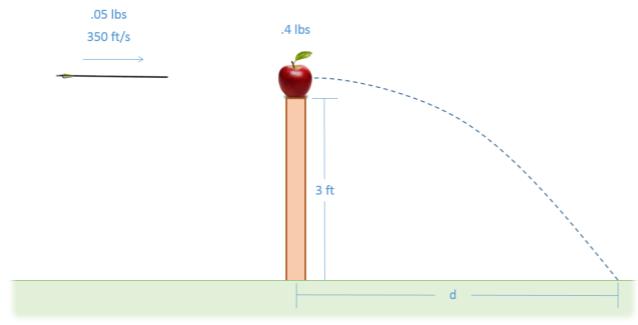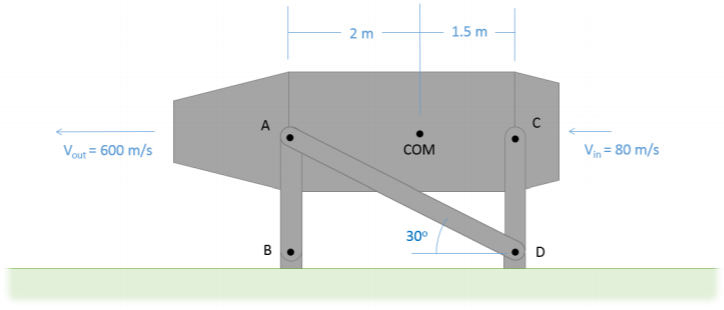10.6: Chapter 10 Homework Problems
- Page ID
- 54748
Exercise \(\PageIndex{1}\)
A jackhammer exerts the impulse shown below on the 1.5-kilogram bit to drive it towards the ground. If the bit starts at rest, what will the expected velocity of the bit be at the end of the impulse?
.png?revision=1)
- Solution
-
\(v = 90 \, m/s\)
Exercise \(\PageIndex{2}\)
A 0.05-lb arrow traveling at 350 ft/s impacts a 0.4-lb apple on the top of a post that is 3 feet tall. If the arrow becomes lodged in the apple, how far would we expect the apple to travel \((d)\) before hitting the ground?
.png?revision=1)
- Solution
-
\(d = 16.8 \, ft\)
Exercise \(\PageIndex{3}\)
A basketball impacts a metal surface as shown below. If the initial velocity of the basketball was 3 ft/s straight down and the coefficient of restitution is 0.85, what is the expected speed and direction \((\theta)\) of the ball after the impact?
.png?revision=1)
- Solution
-
\(v = 2.64 \, ft, \, \theta = 36.25°\)
Exercise \(\PageIndex{4}\)
Puck A, traveling with an initial velocity of 5 m/s, strikes the stationary Puck B. Assuming the collision is elastic, what will the velocity of each puck be immediately after the collision?
.png?revision=1)
- Solution
-
\(\vec{v}_{A, f} = [-3.34, 1.67] \, m/s \)
\(\vec{v}_{B, f} = [-3.34, -3.34] \, m/s \)
Exercise \(\PageIndex{5}\)
A jet engine with a mass of 700 kg and an air mass flow rate of 50 kg/s is mounted to a stand as shown below (a set of legs on each side, only one half shown). Based on the input and output velocities shown below, determine the thrust force of the engine and the forces in stand members \(AB\), \(AD\), and \(CD\). Be sure to indicate if each member is in tension or compression.
.png?revision=1)
- Solution
-
\(F_{thrust} = 26 \, kN\)
\(F_{AB} = 6.04 \, kN \, T\)
\(F_{AD} = 15.01 \, kN \, C\)
\(F_{CD} = 1.96 \, kN \, C\)


